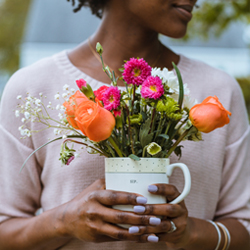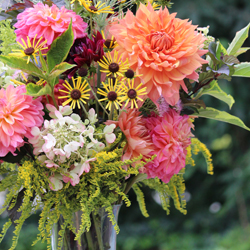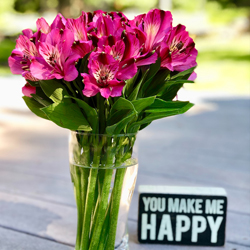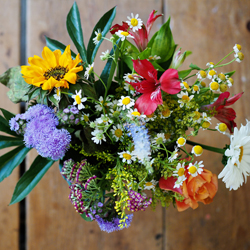It’s easy to be mindful, focused, and involved when you are planting flowerbeds and nurturing each bloom to achieve its fullest, brightest beauty. But cutting, arranging, and enjoying your flowers can also bring you peace and focus even away from your garden when you create thoughtful bouquets.
The Joy of Cutting Flowers
Flowers are meant to be enjoyed, and creating beautiful bouquets from your flowerbeds can help you enjoy your blooms in many places rather than just in your landscape or garden. You could use bouquets to bring the colors, scents, and textures of nature inside your home as decorative accents or table centerpieces, or you can take a bouquet to the office, share one with a neighbor, or give flowers as a gift. The more thoughtful your bouquet, the more joy it will bring to you and everyone who sees the blooms.
Adding Focus to Your Flower Bouquets
Many people find gardening to be a calming, centering practice, and cutting flowers from your beds and arranging them into bouquets can be equally refreshing and restorative. The key is to be very deliberate as you arrange flowers into bouquets, considering each step of the process as a way to continue connecting with your garden rather than a separate chore. From first snipping the stems to sharing the bouquet, every step of arranging a bouquet can be a way to focus and enjoy your flowers.
- As you visit your flowerbeds and choose which flowers to cut for a bouquet, recall the work and effort it took to create these blooms. From planting seeds or seedlings to watering, weeding, pruning, fertilizing, composting, and other care, each step was necessary to bring each particular bloom to the beauty it has reached. Savor that effort and the beauty you grew.
- Focus on each flower to cut it carefully, using smooth, firm motions with sharp pruning shears to create a clean, healthy cut. Feel the stems and their rigidity and texture, and note where foliage branches off from each stem so you can either trim it if necessary, or else incorporate that foliage into your vision of a beautiful, thoughtful bouquet.
- Consider the colors of the flowers you choose for each bouquet in order to invoke the mood you would like. For a soothing bouquet, consider cool colors in blues and purples. Yellow and pink blooms can spread happiness, while red and orange shades help focus energy and enthusiasm. Whites and creams are peaceful shades, and green foliage is a great accent for any hue.
- In addition to color, flowers can also be chosen for deliberate symbolism. If the bouquet is meant to be a gift, opt for the recipient’s favorite flowers or colors to add an extra layer of thoughtfulness to the arrangement. Some blooms even have more deliberate symbolism, such as flowers associated with birthdays, state flowers, and similar meanings. Daisies, for example, represent innocence and loyalty, while zinnias let someone know you’re missing them, and chrysanthemums show optimism and joy.
- All your senses should be incorporated into a thoughtful bouquet. While colors please the eyes, don’t forget floral aromas to please the nose. Gardenias, lilacs, roses, jasmine, and lavender are all aromatic blooms that can bring freshness and beauty far past just the visual appeal of the bouquet, and give you another way to enjoy every flower in the arrangement.
- Textures are another part of bouquets, though textures are often overlooked. Consider each bloom carefully – the shape of the petals, the overall shape and size of the bloom, and the difference in textures on foliage, petals, and floral centers. Create an inviting bouquet that encourages gentle touching to fully engage your senses.
- Think creatively when adding extra foliage and accents into a bouquet, and don’t reject untraditional options. Adding a sprig of herbs or ripe grains to a bouquet can really make it stand out and enhance the entire bouquet. A long feather, a sprig of berries, or a twig with distinctive bark or a unique shape can all be interesting focal points in a mindful bouquet.
Finally, when you’ve arranged your bouquet, it is important to give it thoughtfully so it can be enjoyed as it was intended. If you are arranging the flowers for your own pleasure, place them in a visible spot where you will see them often and they will always bring you back to your garden. If the bouquet is to be a gift, offer it with true kindness and appreciation so the recipient can freely and fully enjoy not only the flowers, but the intention behind them. Consider giving the gift for a unique occasion, such as the anniversary of becoming friends, a 6-month birthday, or a fun holiday such as Herb Day (May 4 – perfect for a bouquet with herbs), Say Something Nice Day (June 1 – a great day to celebrate friends), or I Forgot Day (July 2 – ideal for any special occasion you’ve forgotten!).
Grown, cut, arranged, and given with great care and thoughtfulness, your flowerbeds and the flowers in them will bring wonderful joy not only to you, but to everyone you hold dear.




